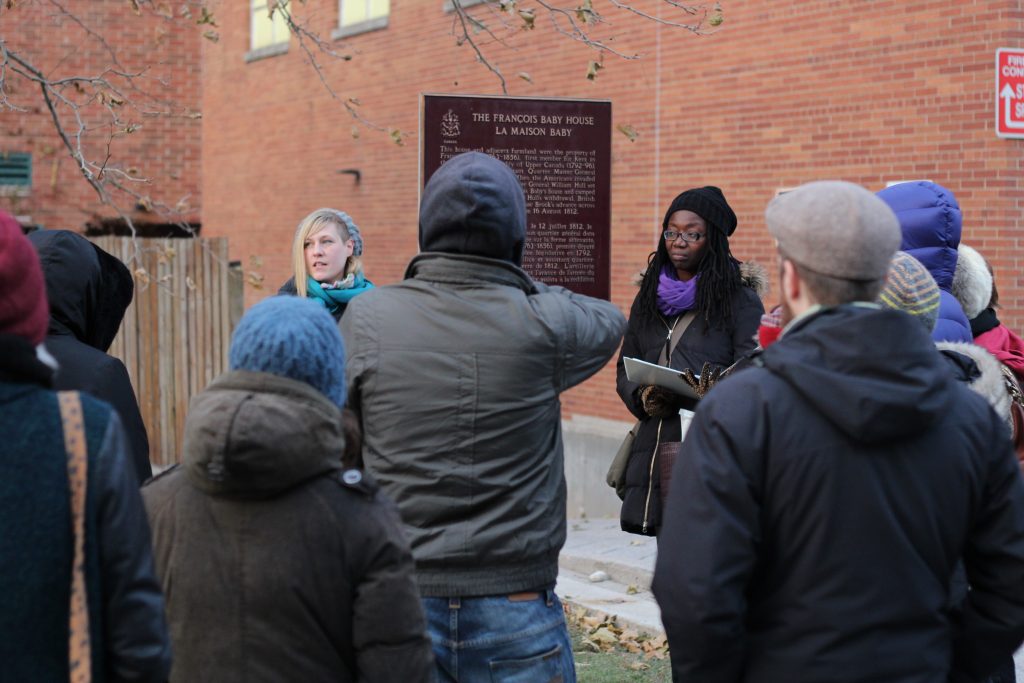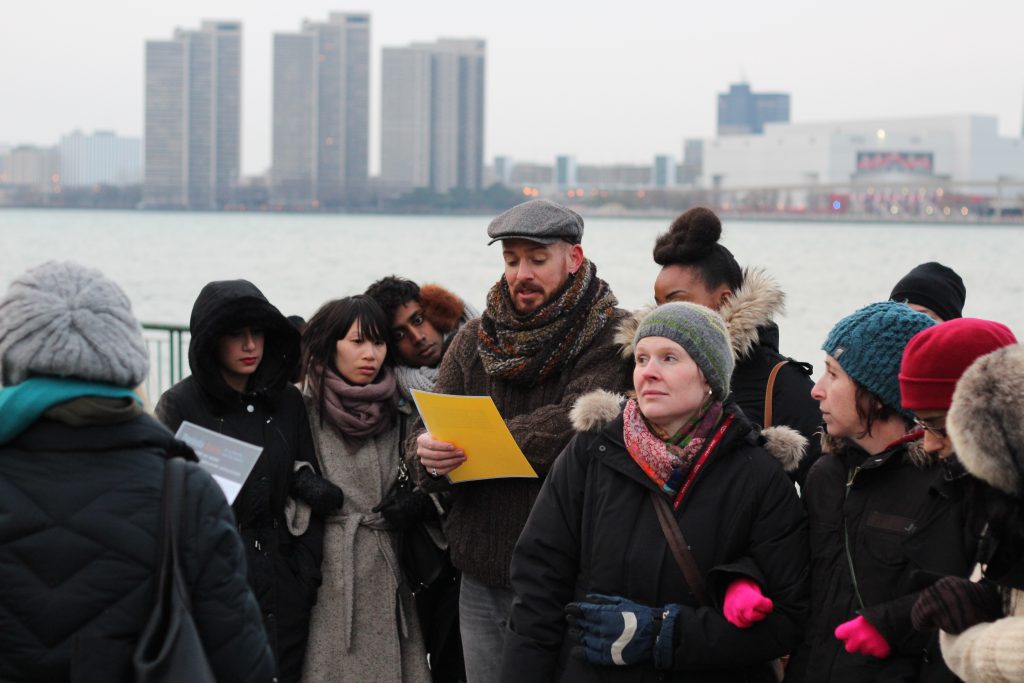Landscape of Forgetting (2014)
by August Klintberg

The enslavement of Indigenous and Black people by white settlers is an often-obscured fact of Canadian history with ongoing impacts in the present. In 2014, artists Camille Turner and Alana Bartol made this issue the focus of a collaborative artwork through a site-specific, performative outdoor tour of sites in Windsor, Ontario, focusing on the history of slavery in the region called The Landscape of Forgetting (2014). This performative artwork-cum-tour highlights histories of trauma and slavery. The tour equally points to inequities and forms of racism that exist in the present, and it calls for participation and action from its audience–including even those who learn about, but do not directly experience the artwork.
Performing histories and the present
The Landscape of Forgetting is an interactive, scripted tour of city streets, parks, and architecture in Windsor, Ontario. First presented by the artists to a small group of around a dozen audience members who moved together through the city visiting different sites with ties to slavery and racism while reading—and singing—aloud from a script, the performance was the result of many months of research. For example, in one source used by the artists, historian Gregory Wigmore explains that “By 1791, an estimated 500 slaves lived beside the 14,000 free colonists in Upper Canada.”[1]
The script of the project is in the collection of the Windsor Community Museum, where visitors can read it. Additionally, an information sheet that was distributed during the walk is now available online here. The introduction to the sheet reads: “On this walk we will listen for whispers from the past, look for signs of the future and consider how this history continues to shape the present.”

Looking carefully at this document, notice that the places and people mentioned are tied to specific documented events, practices, and actions. Imagine joining this walk, on a cold, grey day faced with brisk winds off the Detroit River, listening to participants reading aloud these difficult, discomfiting facts, or even reading a section aloud yourself. Perhaps the history of pear trees planted by Jesuit Missionaries. The “monuments” section of the City of Windsor’s website describes these trees dating from 1749 as indicators of French settlement on Indigenous land, but Bartol and Turner’s tour adds that Black slaves were once responsible for tending this orchard – a fact not mentioned by the City of Windsor website. In other words, this artwork addresses important events that are often not included in many official and institutional narratives of Canadian history. What other histories are not addressed by monuments and memorials? Further, in dealing with the history of this orchard the artists connect past and present by pointing out that many Black people today have negative associations between urban farming and histories of slavery.

Another stop on the tour is the Maison François Bâby House, now a museum but previously the residence of a local politician in the late eighteenth-century after whom the house is named, also designated as a National Historic Site of Canada. The script for the artists’ performance indicates the former White owners of the house owned at least seventeen slaves, whose names and, in some cases, relationships to one another and specific racial identities, were read aloud on the tour. Links between history and current forms of trauma, racism, and oppression emerge as the walk continues. The tour pauses at a riverfront park featuring Canadian and American flags, at which time the artists read “Flags in public spaces are a visual reminder of official power. The state has the power to create laws to keep people in their place. Josiah Cutan, a young enslaved man was bought and sold 5 times.” They explain that during a likely attempted escape, Cutan burgled a local store, was apprehended, and was then the first person in Upper Canada ever to be executed. The tour script then reads “In this case, White fear was used to justify violence against an unarmed Black youth. Today this scenario continues. Just across the river On November 2, 2013, 19-year-old Renisha McBride was driving her car through a white Detroit neighbourhood. She got into an accident and went looking for help. She knocked on a door and was shot in the face. The man who shot her said he was scared and he acted out of self-defense. This is just one story. There are other recent examples like Trayvon Martin and Mike Brown. These cases are a reminder that the past is still with us. We need to acknowledge and understand the past in order to imagine the future.” Through detailed passages like this, the performance invites reflection on and protest against institutionalized and systemic racism in the present.
Artists on site
Many site-specific art practices, emerging as early as the 1970s, ask how knowledge is embedded in a place. Being “site specific” means that the artwork has a relationship to a particular place, and that it would either be destroyed or greatly changed if it were exhibited elsewhere. And yet The Landscape of Forgetting’s narratives of racial oppression reach well beyond Windsor to other parts of Canada, the United States, and even internationally. Paradoxically, while this project is site specific because it deals with slavery in a particular locale, the enslavement of Black and Indigenous people by White people was enabled by pan-continental trade of enslaved people. Indeed, since the endemic effect of racism is a central theme of the artwork, this site-specific work calls for attention to anti-Black racism well beyond Windsor.

Artists in the archives
Is it possible to read an archive against the grain by thinking about what information has been left out of an archive? Archives were central in shaping this project, particularly the archives of the Bâby House and the University of Windsor Archives. Bartol poses the question: “How do you talk to the institution you’re trying to collaborate with when maybe they are trying to shut that conversation down?” Archives, while rich resources for artists, have many gaps, and demonstrate forms of prejudice and exclusion. Where, then, can one look for more information? Newspaper articles, academic research, and conversations with local residents fueled the project, including one resident who showed them an historic object from their family archive: a bill of sale for an Indigenous enslaved person from the region.
Whose histories?
It may seem unusual for an artwork to take the form of a public tour. In fact, many contemporary artists have used scripts and performances of this sort to study sites. Equally, contemporary artists often work closely with a range of collaborators like historians and archivists to study how knowledge and histories are deliberately hidden, and how knowledge about place can be represented. The terms “social practice” and “socially-engaged art” can be useful in talking about artworks of this kind , since they refer to artists working in close dialogue with a range of collaborators or participants who are not necessarily trained or practicing artists. Often, social practice projects give resources and creative agency to a large team of people. With The Landscape of Forgetting, two specific artists catalyzed this project, but in fact it is the product of contributions from many people. Do certain people have greater connection with or rights to tell stories or relay histories based on their lived experience? In this case, Bartol and Turner are both equally invested and imbricated in the very topics they are commenting on and profiling in their work, because they are Canadian citizens. They are critiquing the forms and frequencies by which these overlooked Black histories have been shaped, obscured, or avoided in Canada.
Acknowledgements
The author would like to thank Camille Turner and Alana Bartol for participating in this study through interview, discussion, provision of documents and images. Turner and Bartol have also contributed to the list of further reading.
About the author
Dr. August Klintberg is Associate Professor of Liberal Studies at Alberta University for the Arts. Klintberg is an artist who works in the field of art history. He is represented by Pierre François Ouellette art contemporain in Montreal, Canada. He earned his Ph.D. in Art History at Concordia University in 2013, where he was also an Assistant Professor, LTA. In 2010 he conducted Ph.D. research at Oxford University, St Peter’s College, with the support of the Social Sciences and Humanities Research Council. He completed his MA at Concordia University (2008), his BFA at the Alberta College of Art & Design (2001), and was an exchange student at the Nova Scotia College of Art & Design (1999-2000). He is also an International Counselor for the V&A Waterfront / Zeitz MOCAA Curatorial Training Programme (Cape Town, South Africa). His research interests include installation, artist’s cinema, edible art practices, sensory design in museums, and queer theory.
Further reading
Cooper, Afua. 2007. “Acts of Resistance: Black Men and Women Engage Slavery in Upper Canada, 1793-1803.” Ontario History 99.1 (Spring) 2007: 5-17.
Finkelpearl, Tom. 2001. “Introduction: The City as Site.” In Dialogues in Public Art, edited by Tom Finkelpearl, 2-27. Cambridge and London: MIT Press.
Foster, Hal. 1996. “The Artist As Ethnographer.” In The Return of the Real: The Avant-Garde at the End of the Century, 171-204. Cambridge and London: MIT Press.
Henry, Natasha. 2020. “Apology, Truth, and Reparations: The overdue reckoning with Canada’s slave past.” Spacing July 23, 2020.
Krauss, Rosalind. 1979. “Sculpture in the Expanded Field.” October 8 (Spring 1979): 30-44.
Kwon, Miwon. 2002. One Place After Another: Site-Specific Art and Locational Identity. Cambridge and London: MIT Press.
Lum, Ken. 2020. “On Monument Lab.” In Everything is Relevant: Writings on Art and Life 1991-2018, 264-269. Montreal: Concordia University Press.
Miles, Tiya. 2019. The Dawn of Detroit: A Chronicle of Slavery and Freedom in the City of the Straits. New York: The New Press.
Nelson, Charmaine A. editor. Towards and African Canadian Art History: Art, Memory, and Resistance. Concord: Captus Press 2018.
Thomas, Jeff. 2009. “What’s the Point?” In Public Art in Canada, edited by Annie Gérin and James S. McLean, 115-124. Toronto: University of Toronto Press.
Wigmore, Gregory. 2013. “Gregory Wigmore: The Canadian slave trade.” The National Post. October 21, 2013.
- Gregory Wigmore, “Gregory Wigmore: The Canadian slave trade,” The National Post, October 21, 2013. ↵
A form of art made in response to one specific place. Usually, site-specific art is so particular to one place that if it were removed from that site it would lose its meaning, or even be destroyed in the process.
Artistic work that brings together many contributions from people not usually trained as artists, or an artwork that deals with social relationships as if they were material to be “sculpted” and arranged by an artist by hosting events, activities, or opportunities.

